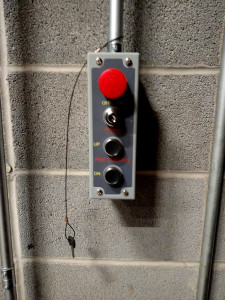Did You Know – Close That Fire Safety Curtain!
By Peter Scheu, ASTC

A Fire Safety Curtain hoist operating station. This station makes closing the fire safety curtain regularly easy. The emergency release is located nearby. Photo courtesy of Steve Miller, University of Cincinnati, CCM.
Often overlooked, the requirement that a Fire Safety Curtain remain closed at all times except when the stage and/or auditorium was in use was codified in the 2010 edition of NFPA 80 (Chapter 20).
As theatre consultants surveying existing venues, we often see older, manually operated Fire Safety Curtain Systems in some sort of disrepair, disabled by tying it off, or otherwise improperly defeated in its operation. The most cited reasons for disabling the systems are they were often too difficult to reset after the curtain has been released in an “emergency mode” (which was pretty much the only way to bring them down) and the concern over the release of fibers when moving older asbestos curtains. The old “free end ball” type of release was also often misapplied and prevented a curtain from descending in even the emergency mode.
In the early 2000s, users disabling Fire Safety Curtains was a common practice, and operational understanding on the part of local code and fire safety officials was lacking. Along with several ASTC members, the Entertainment Services and Technology Association (ESTA) began an effort as part of the ANSI recognized Technical Standards Program (TSP) to, in part, standardize the operation of Fire Safety Curtain systems. Out of that collaborative work came ANSI E1.22 (Entertainment Technology – Fire Safety Curtain Systems).
ANSI E1.22 included the “always closed” requirement, and the standard was eventually incorporated into NFPA 80 and ultimately referenced in today’s national model building codes.
So, why does this requirement exist? The explanatory information in Annex A to NFPA 80, Chapter 20, Part 20.7.1.1 pretty much says it all:
Another unintended benefit is that when a stage is dark, a closed curtain limits backstage access to the front edge of the stage, where a fall could occur in poor lighting conditions. All these reasons can possibly lead to lowered insurance rates if compliance is documented.
To facilitate compliance with the “always closed” requirement, the standard also stipulates that curtains over 800 square feet in area be operated in the “non-emergency” mode by a motorized hoisting system. Why? Because it is far more likely for users to keep a heavier curtain closed when required if opening and closing it is as simple as pushing and holding a button.
Good systems design makes it easier for users to comply with codes and standards intended to protect life and property. Having the Fire Safety Curtain closed when the venue is not being used makes sense and today’s systems make user compliance that much easier.
* – Reproduced with permission of NFPA from NFPA 80, Standard for Fire Doors and Other Opening Protectives, 2019 edition. Copyright© 2018, National Fire Protection Association. For a full copy of NFPA 80, please go to www.nfpa.org.
Disclaimer: Any views or opinions expressed in this article are solely those of the author and do not necessarily represent those of the American Society of Theatre Consultants, nor the author’s employer. This article is for general information only and should not be substituted for specific advice from a Theatre Consultant, Code Consultant, or Design Professional, and may not be suitable for all situations nor in all locations.


